Foreign support of Finland in the Winter War
Foreign support in the Winter War consisted of materiel, men and moral support to the Finnish struggle against the Soviet Union in the Winter War. World opinion at large supported the Finnish cause. The Second World War had not yet begun in earnest and was known to the public as the Phoney War; at that time, the Winter War saw the only real fighting in Europe besides the German and Soviet invasion of Poland, and thus held major world interest. The Soviet aggression was generally deemed unjustified. Various foreign organizations sent material aid, such as medical supplies. Finnish immigrants in the United States and Canada returned home, and many volunteers (one of them future actor Christopher Lee) traveled to Finland to join Finland's forces: 8,700 Swedes, 1,010 Danes (including Christian Frederik von Schalburg, a captain in the Danish Royal Life Guards and later commander of the Free Corps Denmark, a volunteer unit created by Nazi Germany in Denmark during World War II), about 1,000 Estonians, 850 Ukrainians,[1] 725 Norwegians, 372 Ingrians, 366 Hungarians,[2] 346 Finnish expatriates, more than 20 Latvians and 190 volunteers of other nationalities made it to Finland before the war was over.
| Winter War |
|---|
| Articles |
| Related topics |
Pope Pius XII condemned the Soviet attack on 26 December 1939 in a speech at the Vatican and later donated a signed and sealed prayer on behalf of Finland.[3]
Hungary
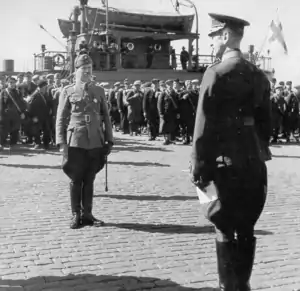
"Only Hungarians sent volunteers as an organized unit according to the initial Finnish requirements."[2] When the Winter War broke out between Finland and the Soviet Union, many Hungarians felt great sympathy towards the Finns and wanted to help them.
The Hungarian government officially did not support Finland, but secretly started to search for ways to help. In addition, non-governmental organisations began to organize support for Finland. Hungary helped Finland by giving monetary donations, armaments and military volunteers. Nobel Prize winner Albert Szent-Györgyi offered all of his prize money to Finland.
Count Pál Teleki's government sent armaments and war equipment valued at 1 million Hungarian pengős during the Winter War (with knowledge and accord of Regent Miklós Horthy de Nagybánya). The recruiting of volunteers started on 16 December. During the Winter War, around 25,000 Hungarian men applied to fight in Finland; finally, 350 applications were accepted. Their military training started at 10 January and it took almost a month. The volunteers formed a battalion what was commanded by Lieutenant Imre Kémeri Nagy. The Hungarian Volunteer Detached Battalion had 24 officers, 52 non-commissioned officers, 2 physicians and 2 military chaplains for a total of 346 officers and men.
Travel to Finland was very difficult as the German Reich forbade transit of armaments and war equipment across its territory (including the occupied Polish territories). Therefore, volunteers had to travel across Yugoslavia, Italy, France, the United Kingdom, Norway and Sweden to make their ways to Finland. They travelled without any weapons by a special train, officially classified as "tourists going to ski-camp". Finally the battalion arrived in Finland at 2 March after 3 weeks travelling.
In Finland the battalion was quartered in Lapua, in the training center of the international volunteers. In Lapua they took a part in further military training, learning skiing and winter warfare. Before the Hungarian battalion could see military action, the Moscow Peace Treaty was signed, on 12 March in Moscow, leaving many volunteers frustrated.
In the last days of March, Field Marshal Mannerheim visited Lapua where he met the Hungarian battalion. He expressed his thanks to the volunteers for coming to Finland and he promoted Lieutenant Imre Kémeri Nagy to Captain. From 17 April to 19 May, the Hungarian battalion served in Karelia, at the new state border in Lappeenranta.
The Hungarian battalion was embarked at Turku at 20 May 1940, from where a steamboat sailed to Stettin, German Reich (now Szczecin, in Poland). They traveled across the German Reich by a special train with a German guard. The volunteers arrived at Budapest on 28 May.
Besides the Hungarian Volunteer Detached Battalion, other Hungarian volunteers fought in the Winter War in the Finnish army, travelling to Finland individually. 2nd Lieutenant Mátyás Pirityi served in the Finnish Air Force and took part in more than 20 sorties. Warrant Officer Vilmos Békássy's plane disappeared over the Gulf of Bothnia. Géza Szepessy, along with four fellows from the Military Technical College of Berlin, went to Finland where he was wounded in action.
The story of the Hungarian volunteers was published by Antal Ruprecht in a bilingual (Hungarian and Finnish) book in 2003.
Italy
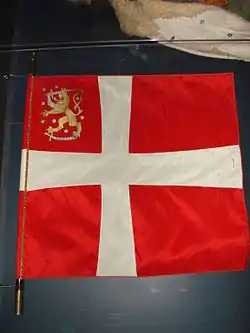
As a fascist government, the Kingdom of Italy had staunchly supported Francisco Franco during the Spanish Civil War in his fight against the Second Spanish Republic supported by the Soviet Union. Italy therefore promptly responded to requests by the Republic of Finland for military assistance and equipment for use against the communist government of the Soviet Union. The Royal Italian Air Force (Regia Aeronautica Italiana) sent thirty-five Fiat G.50 fighters, while the Royal Italian Army (Regio Esercito Italiano) supplied 94,500 new M1938 7.35 mm rifles for use by Finnish infantry. However, Germany intercepted most of Italy's aid and only released it once peace had been made.[4] A handful of Italian volunteers also fought in the Winter War on the side of Finland.
Norway
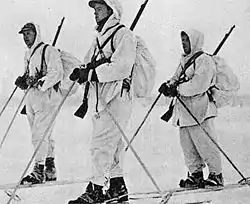
The Norwegian government did not allow officers or under-officers to volunteer for the war in Finland out of fear that this would aggravate the Germans (they wanted to remain neutral at all costs). Of the 725 Norwegians that volunteered to fight for Finland, only 125 made it to the relatively tranquil Salla front and then just three weeks before the war ended. None of the volunteers were killed or wounded. Many of the volunteers were unfit for combat and many ended up in rest homes and institutions for alcoholics during their stay in Finland. Several of the future leaders of the Norwegian resistance movement such as Max Manus and Leif "Shetland" Larsen were among the volunteers. The most highly decorated Norwegian in the later resistance movement, Gunnar Sønsteby, spent his stay as an office clerk (like many of his countrymen in the Winter War).
In addition to the military volunteers, 30 physicians and 40 nurses went to help the Finnish medical system, under the auspices of the Norwegian People's Aid.[5]
There were numerous nationwide collection campaigns of supplies and money in Norway to help the Finns. In all, the Finland collection (Norwegian: Finlandsinnsamlingen) brought in some 2,000,000 kr, the largest popular collection in Norwegian history.[5] Six training aircraft were purchased for part of these funds. Initial flying training was given, close to Oslo, with these aircraft to students sent from Finland.
An important venue for collections for Finland were sporting events, several of which were held for the benefit of Finland in Norway during the war.[6][7][8][9] Some 50,000 backpacks filled with supplies were collected in Norway and dispatched to Finland.[10][11] Collections of rifles (mostly Krag-Jørgensen models) and home knitted shooting gloves also took place. Sigrid Undset, Norwegian author and Nobel laureate, donated her Nobel medal to Finland on 25 January 1940.[12]
The Norwegian government secretly donated to the Finns 12 German-made 7.5 cm field gun m/01s[13] (designated 75 K 01 in Finnish service) in February 1940.[14][15] Included in the covert artillery transfer were 12,000 shells.[16] Norway also allowed the transfer of aircraft to Finland via Sola Air Station, near Stavanger.[17][18][19] Norwegian volunteers took part in the assembly of some of the aircraft at the Saab factory in Trollhättan, Sweden.[17]
One of the main reasons that the Franco-British plan—Operation Avon Head—to send troops to Finland never materialized was that Norway would not allow them to use their ports and territory for troops transfer. They explicitly threatened to fire upon any ship that came near Trondheim or Narvik on that mission.
The North Norwegian county of Finnmark received over 1,000 Finnish refugees from Petsamo by 6 February 1940;[20] as the Red Army advanced through that lightly defended area Finnish civilians sought shelter on the Norwegian side of the Pasvik/Paatsjoki River. By the end of the war, some 1,600 Finnish civilians had fled to Norway.[21] Finnish soldiers of the independent Lapland Group that retreated across the border into Finnmark were transported south and interned at Hegra Fortress in the Nord-Trøndelag county of Central Norway. The internees were released and returned to Finland at the turn of the year 1939–1940.[22] As the Finns had retreated in the northern areas, they had carried out a scorched earth policy, destroying all housing and infrastructure to impede the Soviet advance.[21]
After the end of the war, Norwegian aid continued, shifting to reconstruction aid. When Norway was itself invaded by the Germans on 9 April 1940, the Finnish government immediately announced that the remaining money set off for Norwegian aid work in Finland could be diverted to use in Norway.[5]
Poland
Poland's Prime Minister Władysław Sikorski, despite the ongoing occupation of Poland (since September 1939), had promised to send support in the form of the Polish Independent Highland Brigade to help the Finns in fighting. The help was organised late, however, and never reached Finland.[23] Nevertheless, six volunteers from Poland fought with the Finns during the war.[24]
Sweden
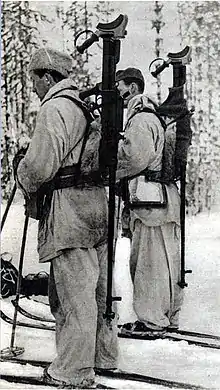
Sweden, which had declared itself to be a non-belligerent rather than a neutral country (unlike for the rest of World War II wherein Sweden tried to uphold neutrality), contributed military supplies, cash, credits, humanitarian aid and some 8,700 Swedish volunteers prepared to fight for Finland. The Swedish Army, which had been downsizing its armed forces since the 1920s, transferred approximately 1/3 of its equipment to Finland, among them 135,000 rifles and 330 guns and large quantities of ammunition.[25] A small number of aeroplanes was given to Swedish Voluntary Air Force, in action from 7 January, with 12 Gloster Gladiator II fighters, five Hawker Hart bombers, and eight other planes, amounting to one third of all the Swedish Air Force's fighters at that time. Volunteer pilots and mechanics were drawn from the ranks. The renowned aviator Count Carl Gustav von Rosen, nephew of Carin Göring, Hermann Göring's first wife, volunteered independently. There was also a volunteer work force of about 900 workers and engineers. In March, the unit was to be reinforced with five Junkers Ju 86 bombers; on 11 March, the bombers were in the Swedish town of Boden with all preparations completed but the end of hostilities on the 13th precluded their deployment.
The Swedish Volunteer Corps, with 8,402 men in Finland—the only common volunteers who had finished training before the war ended—began relieving five Finnish battalions at Märkäjärvi in mid-February. Together with three remaining Finnish battalions, the corps faced two Soviet divisions and were preparing for an attack by mid-March but were inhibited by the peace agreement. Thirty-three men were killed in action, among them the commander of the first relieving unit, Lieutenant Colonel Magnus Dyrssen.
The Swedish volunteers remain a source of dissonance between Swedes and Finns. The domestic debate in Finland had in the years immediately before the war given common Finns hope of considerably more support from Sweden, such as a large force of regular troops, that could have had a significant impact on the outcome of the war—or possibly caused the Soviets not to attack at all. However, the help from volunteers, especially the Scandinavian ones, was appreciated by the Finns. This is shown by the fact that during the Norwegian Campaign against the German invasion in April 1940, a Finnish group of volunteers formed an ambulance unit and helped the defenders until forced to return home because of the success of the German armed forces. A group of Swedish and Finnish volunteers also fought alongside Norwegian soldiers against the German invaders near Os, on 2 May as well.
France and United Kingdom
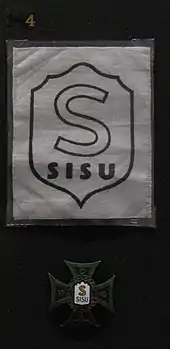
The British government sold the Finnish air force 30 Bristol Blenheim bombers and Gloster Gladiator fighters. U.S.-made Brewster B239 fighters came too late to participate in combat missions, and the same applied to ten Hawker Hurricane I fighters. The British government also provided small arms and ammunition, including a large number of Boys anti-tank rifles in 1939 and 1940.
France also sent aircraft, including the Morane Saulnier M.S.406 fighter. In 1940, it was decided to send a new fighter, the Caudron–Renault C.714. Six C.714s previously marked for shipment to the Polish Air Force were placed in containers and diverted to Le Havre harbour for shipment to Finland. On 12 March 1940, the first six aircraft were already on their way to Finland when news of the armistice between Finland and the Soviet Union was received. At the time deliveries were halted, ten aircraft were in containers at Le Havre waiting to be lifted to the ships and three more were on their way from Paris. The French Army also supplied small arms and ammunition, mostly of obsolete design.
Franco-British plans for intervention
Within a month, the Soviet leadership began to consider abandoning the operation, and on 29 January 1940, via intermediaries in Sweden, Finland's government was approached on the subject of preliminary peace negotiations. Until this point, Finland had fought for its existence as an independent and democratic country. However, at the news that Finland might be forced to cede its territory or sovereignty, public opinion in France and Britain, already favorable to Finland, swung in favor of intervention. When rumors of an armistice reached governments in Paris and London, both decided to offer military support. Although already at war with Nazi Germany, Britain and France put together a combined force of 100 000 troops and 62 bomber aircraft to go to Finland's aid. However this plan was thwarted on the 5th of March when Sweden refused passage, recognizing that defeat was now inevitable. On the 6th of March, President Kallio of Finland authorised a Finnish peace delegation.[26]
United States
The Soviet attack outraged Americans, with some businesses refusing to sell supplies to the Soviet Union. Responding to a call from a manufacturer who refused to sell to the aggressor, the American-Russian Chamber of Commerce compared his objections to "[refusing] to sell to a man because he beats his wife".[27]
In December 1939, sympathetic Americans led by former President Herbert Hoover (who had previously formed the Commission for Polish Relief and, in World War I, headed the Commission for Relief in Belgium) formed the Finnish Relief Fund to donate money to aid Finnish civilians and refugees. By the end of January, it had already sent more than two million dollars to the Finns.[28]
See also
References
Citations
- "How Ukrainians stopped the Stalinist aggression in Finland" (PDF). Archived from the original (PDF) on 6 October 2017. Retrieved 6 October 2017.
- Marcus Wendel. "Axis History". Retrieved 21 December 2014.
- "Uruguay to aid Finland". Finnish Defence Forces. 1999. Archived from the original on 14 June 2007. Retrieved 10 July 2009.
- Quigley, Carroll (1966). Tragedy And Hope. New York: Macmillan. p. 682. ISBN 0-945001-10-X.
- "Finlands krig var også Norges krig; Norsk Folkehjelps historie del 4". Norwegian People's Aid (in Norwegian). 30 September 2005. Retrieved 1 February 2010.
- "Finland to receive a railway wagonload of food aid from Denmark". Finnish Defence Forces. 1999. Archived from the original on 23 March 2008. Retrieved 25 December 2008.
- "Brazil sends Finland 10,000 sacks of coffee". Finnish Defence Forces. 1999. Archived from the original on 9 October 2007. Retrieved 25 December 2008.
- "No respite for Viipuri". Finnish Defence Forces. 1999. Archived from the original on 9 October 2007. Retrieved 25 December 2008.
- "Kollaa still holding out!". Finnish Defence Forces. 1999. Archived from the original on 9 October 2007. Retrieved 25 December 2008.
- "Mine sinks Soviet submarine". Finnish Defence Forces. 1999. Archived from the original on 15 October 2009. Retrieved 25 December 2008.
- "Finnish troops capture three Soviet spies". Finnish Defence Forces. 1999. Archived from the original on 9 October 2007. Retrieved 25 December 2008.
- Finnish Defence Forces official website: The Winter War – Day 57 Archived 2 May 2009 at the Wayback Machine
- "Norwegian weapons". Archived from the original on 16 July 2011. Retrieved 21 December 2014.
- Winterwar.com: Finnish Artillery pieces – 75 K 01
- Winterwar.com: Artillery acquisitions during the Winter War
- "Neutrality guard" (in Norwegian). NorgesLexi.com. Archived from the original on 15 March 2012. Retrieved 29 August 2008.
- Fighter Tactics Academy: Brewsters to the Finnish Air Force in 1940
- Fighter Tactics Academy: Hurricanes to Finland
- Secret Mission To Fly Twelve Bristol Blenheims To Finland BBC – World War 2 People's War
- "Mannerheim Line holds firm on the Isthmus". Finnish Defence Forces. 1999. Archived from the original on 6 January 2008. Retrieved 10 July 2009.
- Sørensen, Svein H. (2001). Garnisonsgammen i Svanvik – og glimt fra grensevakten i mellomkrigstida (in Norwegian). Oslo: Norwegian Armed Forces Museum. p. 41. ISBN 82-91218-25-0.
- Fornes, Greta. "Ingstadkleven Fort, 1926–1940" (in Norwegian). Archived from the original on 15 January 2009. Retrieved 10 July 2009.
- "Media społecznościowe i e-marketing w praktyce BLOOG".
- "Niezależna Gazeta Obywatelska w Opolu". Retrieved 21 December 2014.
- Carl-Axel Wangel et al. "Sveriges militära beredskap 1939–1945", p 136 (Köping 1982) ISBN 91-85266-20-5
- War Monthly Issue 12 p40 March 1975
- "FOREIGN TRADE: Amtorg's Spree". Time. 19 February 1940.
- "THE CONGRESS: Sounding Trumpets". Time. 29 January 1940.
Bibliography
- Andersson, Lennart B3 Junkers Ju86 i Sverige
- Cox, Geoffrey (1941) The Red Army Moves (Victor Gollancz, London).
- Engle, Eloise & Paananen, Lauri (1992). The Winter War: The Soviet Attack on Finland 1939–1940. Stackpole Books. ISBN 0-8117-2433-6.
- Jakobson, Max (1961). The Diplomacy of the Winter War: An Account of the Russo-Finnish War, 1939–1940. Cambridge, Massachusetts: Harvard University Press.
- Öhquist, Harald (1949). Talvisota minun näkökulmastani. Helsinki: WSOY. (in Finnish)
- Ries, Tomas (1988). Cold Will: Defence of Finland. Brassey's. ISBN 0-08-033592-6.
- Schwartz, Andrew J. (1960). America and the Russo-Finnish War. Washington, D.C.: Public Affairs Press.
- Tanner, Väinö (1957) The Winter War: Finland against Russia 1939–1940 Stanford University Press, California; also London.
- Trotter, William R. (2002) [First published 1991 in the United States under the title A Frozen Hell: The Russo–Finnish Winter War of 1939–40]. The Winter war: The Russo–Finno War of 1939–40 (5th ed.). New York (Great Britain: London): Workman Publishing Company (Great Britain: Aurum Press). ISBN 1-85410-881-6.
- Upton, Anthony F. (1974). Finland 1939–1940 (University of Delaware Press, Newark: part of series The Politics and Strategy of the Second World War) ISBN 0-87413-156-1
- Van Dyke, Carl (1997). The Soviet Invasion of Finland, 1939–40. Frank Cass Publishers. ISBN 0-7146-4314-9.
- Vehviläinen, Olli (2002). Finland in the Second World War: Between Germany and Russia. New York: Palgrave. ISBN 0-333-80149-0.
- "Finland i Krig 1939–1940" – multiple authors. ISBN 951-50-1182-5
- Ruprecht, Antal (2003). Magyar önkéntesek a Téli háborúban [Hungarian volunteers in the Winter War]. Hadtörténeti Intézet és Múzeum, Budapest (text in Hungarian and Finnish).